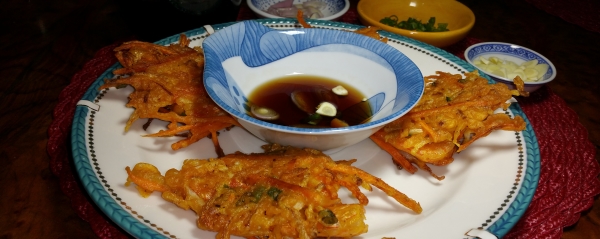
Most English language sources for this recipe call for a batter made from cornstarch, although rice flour might be more authentic and is available in Asian markets here. The shrimp should be small, this is not a time to be using jumbo prawns! Some recipes also call for using dried shrimp (shell on) for a greater concentration of flavor. If you decide to shell the shrimp, put the water from this recipe on the stove, add the shrimp shells, boil for 2 minutes, and then strain the liquid. Let the liquid cook, and then use it for the batter. Another great use for the shrimp shells is to heat them gently in butter, and then strain and cool the butter which can be used with any dish you might want to add a shrimp taste to. De-veining the shrimp is up to your discretion. Some ukoy are made with head and tail shrimp that sit on top of the fritter, and in some the battered fritter is place on top of a small square of banana leaf and then lowered into the frying oil.
Sawsawan is the Filipino term for a variety of sauces, and such sauces are a important distinguishing feature of Filipino food.There are many varieties of sawsawan that go with many different dishes. Filipino professor, publisher, and food columnist Doreen Gamboa Fernandez has written that sawsawan is one of the ways in which Filipinos "indigenize" foreign foods that have become part of their cuisine: that is, taking an unfamiliar or new food and adjusting the taste to Filipino palates. She goes on to say that the relationship between the chef and the diner is not dominating. Instead the diner mixes their sawsawan to their own particular preference with the full assent of the chef who recognizes the diner as an active participant in the culinary process. So one way of serving ukoy is to provide all the ingredients for the sawsawan and let each diner mix their own right at the table! Fernandez's research and writings were less concerned with the question of "authenticity" in Filipino foods than "how dishes became Filipino," a scholarly acknowledgement of the syncretism of culinary culture and a process found throughout the world.1
Ukoy is a popular street and party food in the Philippines, but it has made its way to restaurant menus as well. It is thought to have originated in Laguna, which is in the southeast part of Luzon. This area is also famous for their coconut cream pie called "Buko pie". There is considerable variation in the ingredients used in Ukoy, although essential ingredients are shrimp and mung bean sprouts. Some recipes call for adding small cubes or strips of tofu; others use carrots, squash, cabbage or even green papaya.
The anatto powder, from the "lipstick tree" bixa orellana, is used mostly to give the fritter a brighter reddish color. Anatto (or Achote) is used in many Latino dishes and was traditionally also used as a dye for fabrics and for lipstick. I would imagine that paprika would be a reasonable substitute, but there are many markets in San Diego where anatto may be found.
Ingredients:
- 1 cup small to medium raw shrimp washed and de-veined but with shell left on*
- 1 cup mung bean sprouts
- 1 cup sweet potato cult into thin sticks (julienned)
- 1 medium onion sliced thin
- 2 scallions finely chopped
- 1 cup rice flour or cornstarch
- 1/2 cup all purpose flour
- ½ teaspoon baking powder
- 1 teaspoon anatto powder (also called achiote)
- 1 egg
- ½ teaspoon salt
- ½ teaspoon ground black pepper
- 1 ¼ cups water
Sawsawan:
- 4 cloves garlic, minced
- 1-2 shallots sliced thin
- 2 tablespoon sugar
- ¾ cup white vinegar
- ¼ cup water
- 3 tablespoon soy sauce
- 3 small hot peppers sliced small
* It is best to use small shrimp in their shells. Sacrificing a bit of taste you can make this with peeled shrimp.
Preparation:
- De-vein the shrimp, using the following method: Make a small 1/3" longitudinal cut in the shell along the back from the big end. With a toothpick, gently fish out the black vein clamping the vein between your thumb and the toothpick. Gently pull the vein out in a straight motion.
- Place dry ingredients (cornstarch, flour, baking powder, anatto powder, salt pepper) in a mixing bowl; add egg and water and whisk into a smooth batter.
- Fold the shrimp, bean sprouts, sweet potatoes, scallions and onion into the batter, mixing thoroughly to coat all the ingredients.
- Fill a deep frying pan or pot with about 1 inch of cooking oil. Heat oil to 350 to 375 degrees.
- With a large metal cooking spoon, scoop up about 3 tablespoons of the battered mixture and lower it into the hot oil.
- Cook on one side for about 3 minutes; then with metal tongs or the metal spoon, gently flip over the fritter and fry for another 2 minutes. Work in small batches; do not overcrowd the pan. When finished, the Ukoy should be golden-brown.
- Remove the Ukoy when it is golden brown and place on either a metal rack (preferred) or paper towels.
- Prepare the vinegar dipping sauce by mixing all the sauce ingredients together and then pour the sauce into individual small bowls, one per diner.
Serve as a snack or with rice and a vegetable dish as a main course.
Tayo'y magsikain, Kainan na!
Recipe by T. Johnston-O'Neill
Photo by Shari Johnston-O'Neill
1 Culture Ingested: On the Indigenization of Philippine Food by Barbara Kirshenblatt-Gimblett.







